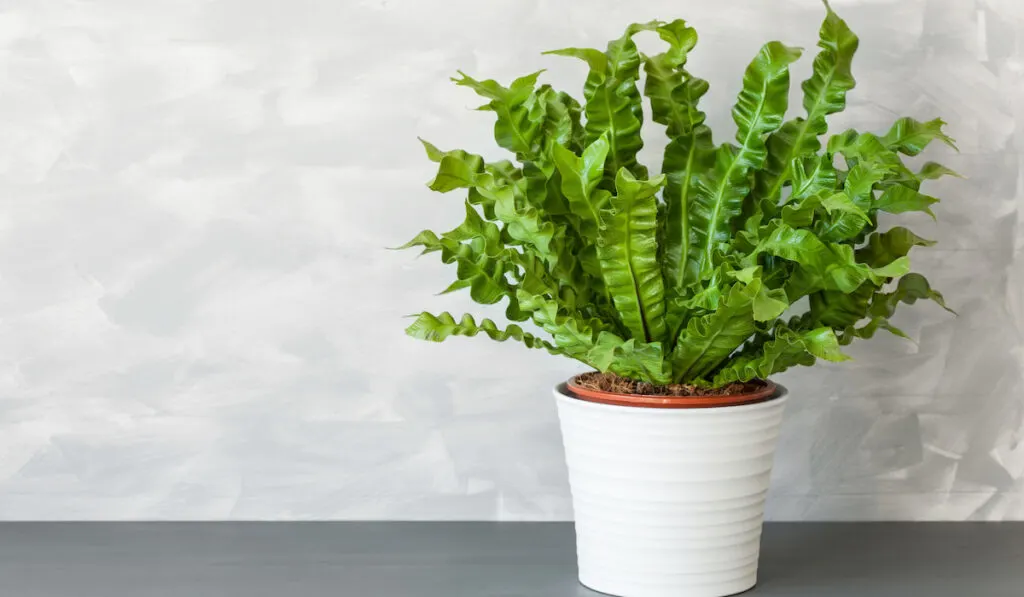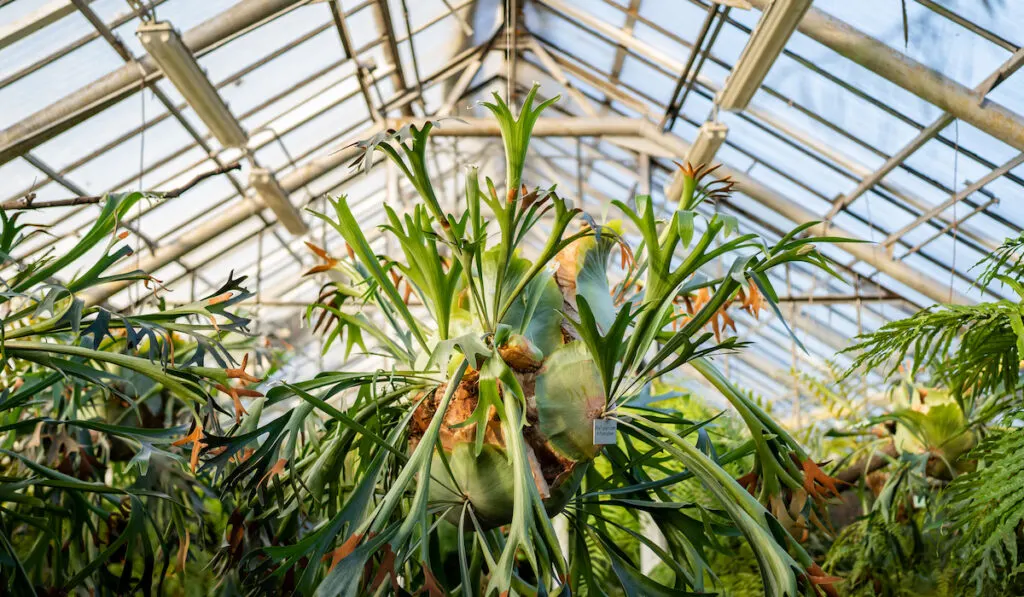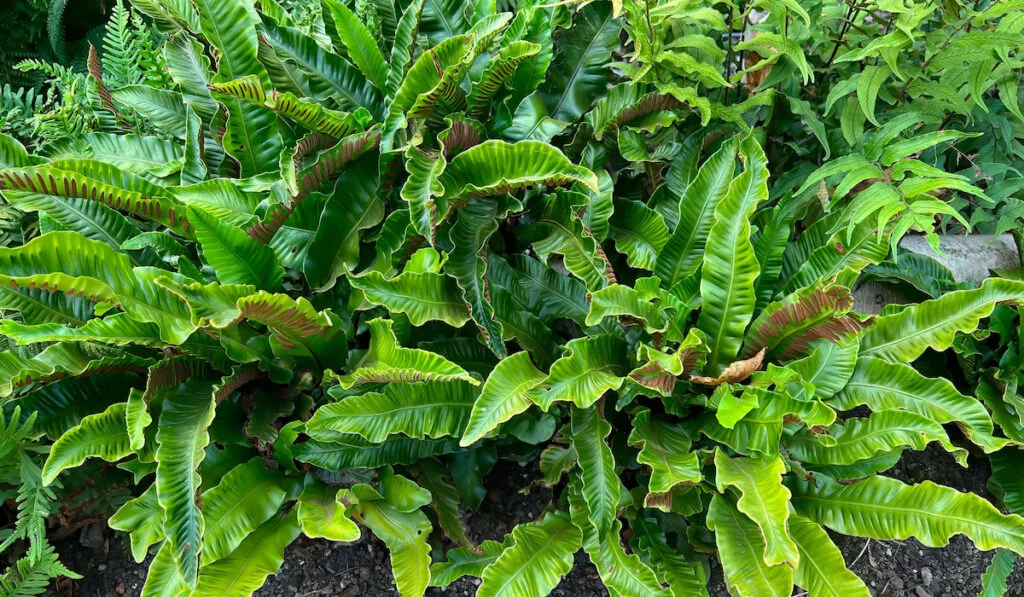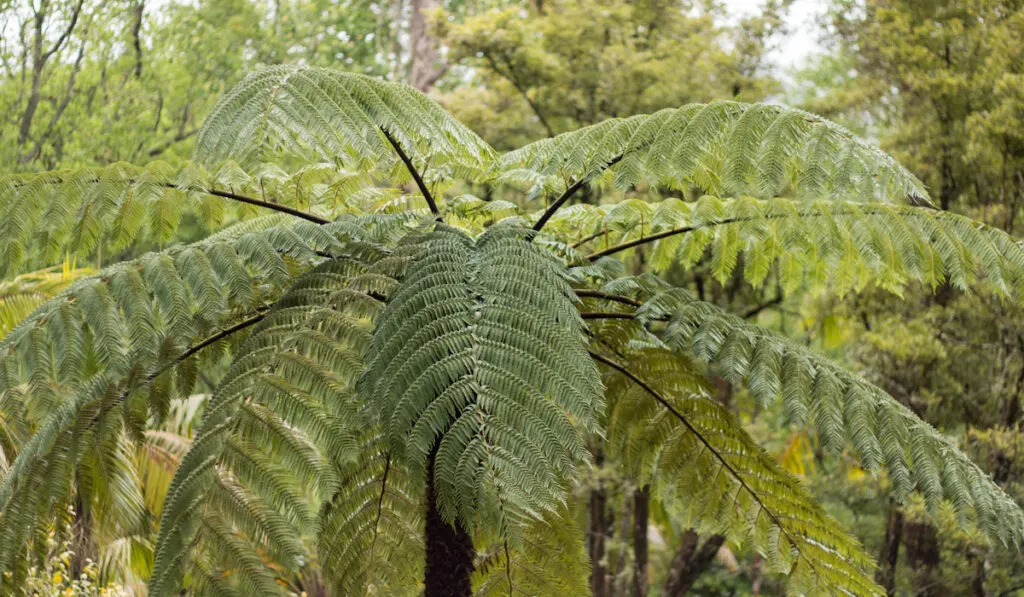Ferns are one of the most adaptable plants you can grow indoors or outside your house.
Some species tolerate cold weather, while others can live with minimal water and sunlight.
And there’s no denying that these vascular plants can make appealing houseplants, regardless of their size.
But if you want to fill that large corner gap or make a statement at your house’s entrance, you need large potted ferns.
So, which big potted ferns can effectively do these jobs? We have shortlisted a few unique species just for you.

Table of Contents
1. Crocodile Fern (Microsorum musifolium)
Crocodile ferns or crocodyllus ferns are native to Australia.
Crocodile ferns have broad, wrinkled light green fronds with dark green veins. From a glance, their fronds’ surfaces resemble the texture of crocodile skins.
These ferns grow 2 to 5 feet tall with a similar spread. They thrive in hardiness zones 10 to 11 and naturally love growing in tropical climates.
It is best to grow these ferns indoors if you live in colder regions with little sun and hot months. You can either plant them in a pot or a hanging basket.
Low-humidity environments can turn their fronds brown. So, be sure to mist or water these ferns regularly.

2. Boston Fern (Nephrolepis exaltata)
Boston ferns grow in many parts of the world, such as Africa, the Americas, and Polynesian regions. In the United States, they grow best in sunny areas and partially shaded areas like Florida and South California.
Also referred to as sword, boss, and ladder ferns, Boston ferns have bluish-green fronds with pinnate leaves and long, arched stems.
On average, Boston ferns grow 2 to 3 feet tall and spread 1 to 2 feet wide. They thrive in hardiness zones 10 to 12 and grow best in slightly acidic, well-drained soils.
When growing these ferns, you should plant them in areas with partial shade.
If they grow indoors, mist or water them regularly to avoid low-humidity environments that can affect their growth.

3. Bird’s Nest Fern (Asplenium nidus)
Bird’s nest ferns or nest ferns are indigenous to Australia, Asia, and Africa. In the wild, they are tropical epiphytes that grow on trees or surfaces of other plants.
It is easy to identify bird’s nest ferns by their shiny, lance-shaped, erect green fronds that grow in a circle to form a bird’s nest shape.
If you grow bird’s nest ferns outdoors, these ferns can extend up to 5 feet tall and spread 2 to 3 feet.
But if they grow indoors in pots, their sizes reach 1 to 2 feet tall with the same spread. So, you don’t have to worry about these ferns taking up too much of your space.
Bird’s nest ferns prefer partially shaded areas. They also love slightly acidic and well-drained soil.

4. Staghorn Fern (Platycerium spp.)
Staghorn ferns are native to Australia, Southeast Asia, and Africa. They are also known as antelope ears and elkhorn ferns.
These epiphytes usually grow on trees in their natural habitats. However, you can still plant them in containers or hanging baskets.
Staghorn ferns possess broad and long dark green leaves that resemble the shape of antlers. They grow 2 to 3 feet tall with the same spread.
These ferns thrive and grow in partially shaded areas. If you keep them outdoors, avoid bright and direct sunlight to prevent their fronds from burning or turning brown.

5. Delta Maidenhair (Adiantum radianum)
Deltan maidenhair ferns are indigenous to South America. Their wild habitats include riverbanks, streams, forest floors, rock crevices, and coastal cliffs.
You can spot delta maidenhair ferns by their arched, light fronds with many small bright green pinnate leaves.
On average, delta maidenhair ferns grow 17 to 19 inches tall and spread 22 inches wide. However, the maximum height they can reach is 59 inches tall.
These ferns thrive in high-humidity environments with adequate exposure to indirect sunlight. Although they make excellent indoor houseplants, you can also grow them outside.
Be sure to place delta maidenhair under shade when they grow outdoors. And water these ferns regularly to keep the soil moist.

6. Kangaroo Paw Fern (Microsorum diversifolium)
Kangaroo paw ferns are native to Australia and New Zealand. They are also called kangaroo ferns, kangaroo foot ferns, and hound’s tongues.
Kangaroo paw ferns possess leathery, dark green arched fronds that resemble kangaroo’s feet. From a quick glance, some people confuse kangaroo paws and blue star ferns.
However, you can recognize a few key distinctions between these two different species. First, blue star ferns have bluish-green leaves, whereas kangaroo paw ferns have dark green foliage.
And blue star ferns have curled and twisted fronds, whereas kangaroo paw ferns have straight to arched leaves.
Kangaroo paw ferns grow 6 to 12 inches and spread up to 4 feet wide. They grow best under bright, indirect sunlight and in slightly acidic, well-drained soil.

7. Hart’s Tongue Fern (Asplenium scolopendrium)
Hart’s tongue ferns are widely distributed across the world. You can find them in central and southern Europe, northwest Africa, Asia, and the eastern United States.
In the wild, they grow near woodlands, under trees and rocks, and in humid shaded areas. These ferns are also called burnt weeds.
You can recognize hart’s tongue ferns by their glossy green, wavy fronds growing in circles to form a large rosette. Each frond also has tiny orange spores on its undersides.
Hart’s tongue ferns thrive in hardiness zones 5 to 9. They grow 1 to 2 feet tall and spread the same. These ferns also prefer slightly alkaline and moist, well-drained soil.
Aside from being houseplants, you can also use and process their fronds to treat minor health issues like cough, diarrhea, wounds, and other digestive problems.

8. Australian Tree Fern (Cyathea cooperi)
These Australian-native ferns go by many names, such as lacy tree ferns, scaly tree ferns, and Cooper’s tree ferns.
Identifying an Australian tree fern is easy since each plant has long, large, bright green fronds equipped with brown sori on each underside.
Australian tree ferns look similar to a miniature version of the palm tree. In the wild, these ferns can grow up to 50 feet tall.
But if they grow in containers or pots, these plants usually develop 15 to 20 feet tall and spread 10 to 12 feet wide.
These large ferns thrive in hardiness zones 9 to 11. They prefer tropical environments with partial sun and enough humidity.
Australian tree ferns also love slightly acidic and well-drained soil. However, they can tolerate salty soil and bright direct sunlight.
Unfortunately, prolonged exposure to the scorching sun can also turn their leaves brown.

9. Eagle Fern (Pteridium aquilinum)
Eagle ferns are indigenous to Europe, Asia, and North America. They are also known as hog-brake, bracken, and western bracken ferns.
Their natural habitats include deciduous woodlands, hillsides, coniferous forests, and pastures.
You can recognize eagle ferns by their light green triangular fronds and numerous spores under each leaflet.
These ferns thrive in hardiness zones 3 to 8. They can tolerate partial or full sun and prefer slightly acidic and moist soil.
Eagle ferns bear a carcinogenic compound called ptaquiloside in their fronds, spores, and stems. These compounds can cause tumors, digestive cancers, and other serious health issues.
Be sure to put or grow these ferns away from children and animals.

10. Ostrich Fern (Matteuccia struthiopteris)
Ostrich ferns or shuttlecock ferns are native to Asia, Europe, and North America. In the wild, these ferns grow along ponds and streams in shaded woodlands, rain gardens, and humid forests.
You can spot ostrich ferns by their bright green, arched fronds that resemble ostrich feathers. You can also find curled fiddleheads at the base of the fronds that will later grow into new fronds.
These ferns grow 3 to 6 feet tall and spread 5 to 8 feet wide. They also thrive in hardiness zones 3 to 7.
When growing ostrich ferns in pots, water the soil and keep it always moist. Since the bright and direct full sun can turn their fronds brown, place or grow them in partially shaded areas.

11. Cinnamon Fern (Osmundastrum cinnamomeum)
Cinnamon ferns are indigenous to eastern Asia and the Americas. They live in moist and humid environments, especially near prairies, water streams, and shaded forests.
Cinnamon ferns have bright green pinnate leaves. You can also find thick and erect brown fronds projecting from the center part of the plant.
Cinnamon ferns grow 2 to 5 feet tall and spread 2 to 3 feet wide. In an optimum environment, they can reach up to 6 feet tall.
Since these ferns love moist and wet environments, you should constantly water the soil or mist their fronds frequently. They also thrive in hardiness zones 1 to 8 and prefer partially shaded areas.
Final Thoughts
Most fern species listed above are easy to grow with just a little tenderness, love, and care. Yet, these species require transplanting when they mature and grow bigger.
Failing to do so can stunt their growth. Even worse, these ferns can suffocate and die when their roots become too crowded.
Resources
- https://www.guide-to-houseplants.com/crocodile-fern.html
- https://www.gardeningknowhow.com/ornamental/foliage/crocodile-ferns/crocodile-fern-care.htm
- https://www.bhg.com/gardening/plant-dictionary/houseplant/boston-fern/
- https://www.thespruce.com/grow-nephrolepis-boston-ferns-1902723
- https://www.gardenia.net/plant/asplenium-nidus
- https://www.thespruce.com/grow-asplenium-nidus-ferns-1902716
- https://www.gardeningknowhow.com/ornamental/foliage/staghorn-fern/staghorn-fern-information.htm
- https://hort.extension.wisc.edu/articles/staghorn-fern-platycerium-bifurcatum/
- https://www.houseplantsexpert.com/delta-maidenhair-fern.html
- https://en.wikipedia.org/wiki/Adiantum_raddianum
- https://houseplantcentral.com/kangaroo-paw-fern/
- https://www.ourhouseplants.com/plants/kangaroo-paw-fern-microsorum-diversifolium
- https://www.woodlandtrust.org.uk/trees-woods-and-wildlife/plants/ferns/harts-tongue-fern/
- https://www.gardenia.net/plant/asplenium-scolopendrium-harts-tongue-fern
- https://www.thespruce.com/australian-tree-fern-overview-1902715
- https://www.gardenia.net/plant/cyathea-cooperi
- https://www.picturethisai.com/wiki/Pteridium_aquilinum.html
- https://www.inaturalist.org/taxa/52681-Pteridium-aquilinum
- https://www.thespruce.com/growing-ostrich-ferns-5094167
- https://www.gardenia.net/plant/matteuccia-struthiopteris-ostrich-fern
- https://plants.ces.ncsu.edu/plants/osmundastrum-cinnamomeum/
- https://www.gardenia.net/plant/osmunda-cinnamomea-cinnamon-fern
